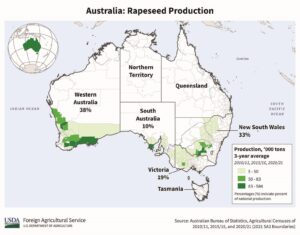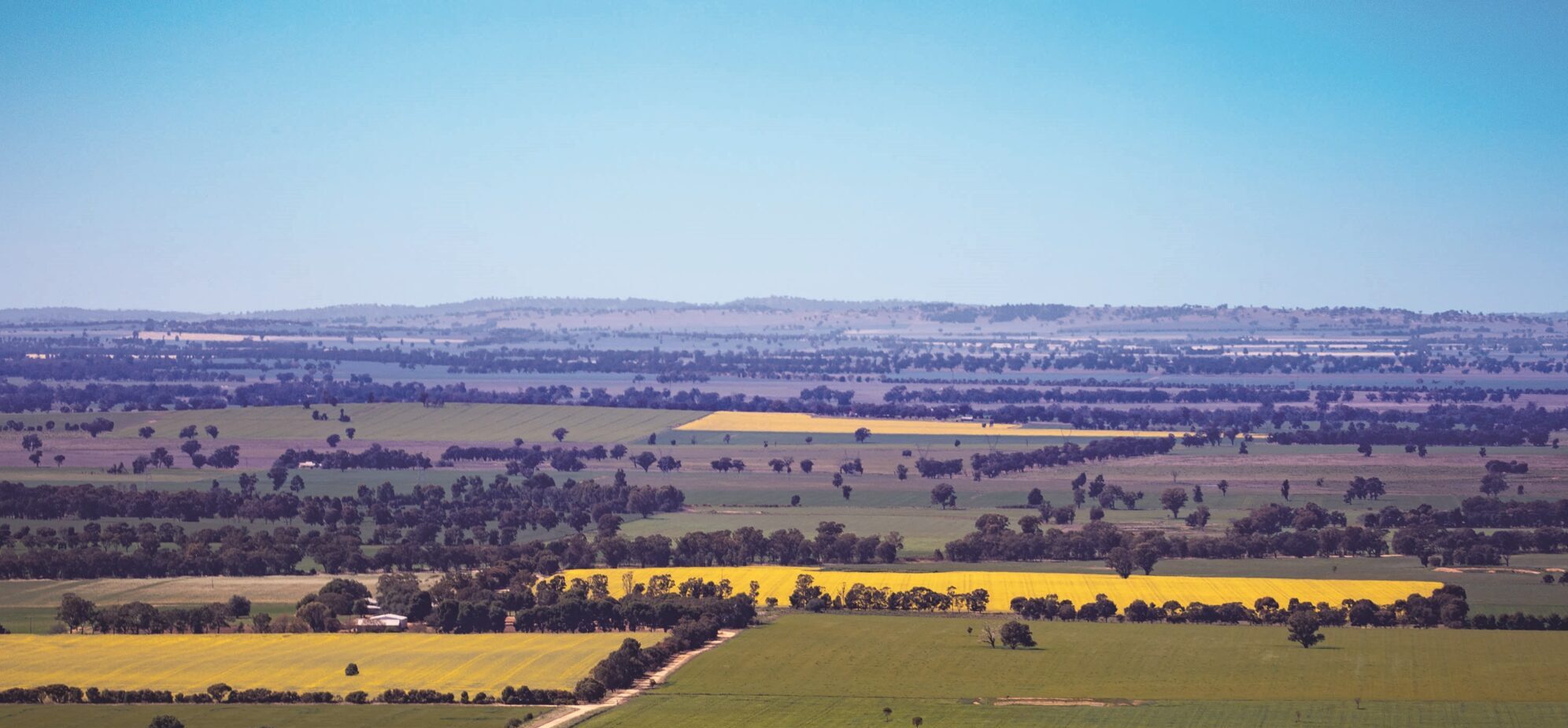Aussie rules
Good moisture powered a run of record canola yields and production in Australia, the land of red soils and often harsh growing conditions. Everything came together in 2022. Building on decent production and prices the previous two years, Australian farmers planted a record 9.6 million acres and achieved the rare two-fer with record yields of 37.8 bu./ac. The winning combination produced a mammoth crop, by Australian standards, of over eight million tonnes, according to figures from the United States Department of Agriculture’s Foreign Agriculture Service. (See the table.)

While forecasts for 2023 are down from 2021 and 2022, mostly due to a return to hot, dry weather, Australia may be at a new threshold for canola productivity. This article describes common agronomy practices and yield robbers in Australia, and may inspire some ideas for Canadian production in warm, dry scenarios.
Seeding and crop establishment
Seed genetics. Australia lifted its ban on genetically modified canola in all states, except Tasmania. Western Australia, which accounts for about half the national canola area and production, has fully adopted herbicide tolerance – especially to manage herbicide-resistant ryegrass and radish weeds. Herbicide-tolerant stacks are common. Stack options include cultivars with both triazine and glyphosate tolerance and combinations that include Clearfield or Liberty Link systems.
Michael Hickey, market development manager for Nuseed in Western Australia, says stacks are also a management tool for carryover of Group 2 herbicides, which are widely used in barley, wheat and pulses. The re-cropping restriction for canola after Group 2s is 34 months. “Due to our low organic carbon combined with low rainfall, the breakdown of Group 2 chemicals can be extremely slow,” Hickey says. Clearfield stacked with glyphosate tolerance, for example, protects establishing canola from Group 2 carryover and provides the glyphosate system for weed control. Roger Rotariu, Nuseed’s North American Marketing Lead, based in Calgary, isn’t sure the Group 2 carryover risk is high enough in Canada to justify this stack.
Australia is also switching rapidly to hybrids. “We see a strong decline of open-pollinated seed being used in Australia due to the high yield penalty compared to hybrid seed, sometimes up to a 20 per cent difference,” Hickey says. Hybrids now account for 60 to 70 per cent of canola market share nationally, according to a 2023 report Canola In Australia: 21st century progress from the Australian Oilseeds Federation and New South Wales Department of Primary Industries.
The top-selling hybrid cultivar in Western Australia in 2023 was Pioneer 44Y27 RR. Peter Bostock is technical support manager, west, for GenTech Seeds, exclusive producer and distributor of Pioneer Hi-Bred seed in Australia. The hybrid has performed consistently across a wide range of environments and “is the quickest hybrid in our current commercial lineup,” Bostock says.
“Quickness” is a thing in Australia, a maturity factor related to how fast cultivars advance from emergence to flowering. Australia’s canola seed industry divides cultivars into four phenological groups based on their rate of development from germination to flowering. Canola In Australia describes the four groups:
1. Fast developing spring types which are preferred in low rainfall zones
2. Fast to mid developing spring types suited to low to medium rainfall zones
3. Mid to slow spring types for medium to high rainfall zones
4. Slow spring to winter types for high rainfall zones and for grazing.
Australia’s canola regions have full-year rainfall of 325mm (13”) to 600mm (24”). This is similar to Prairies precipitation, which ranges from less than 300mm annually in the semiarid grassland to about 700mm in central Manitoba.
Seed treatment. Blackleg is the most significant disease in Australia and protecting seedlings is important, Bostock says. Saltro Duo is a popular fungicide seed treatment, with actives pydiflumetofen, fludioxonil and metalaxyl-M to protect against early blackleg infection as well as damping off diseases. Poncho Plus is a popular insecticide seed treatment with clothianidin and imidacloprip to protect against various insects, including red-legged earth mite, lucerne flea, cutworm, wireworm and aphids. Australian farmers pay the equivalent of Cdn$12 to $20 per pound for top hybrids with seed treatment.
Seeding date. Australian farmers grow most of their annual crops in the winter, which is cooler and tends to have more rainfall, but these are not winter cultivars. Farmers plant spring canola cultivars in March to May, their fall, and harvest in November, their spring.
Australian farmers often set a seeding date based on “optimal start of flowering,” a regionally adjusted date based on heat stress, water stress, frost risk and yield potential. The optimal start seems to be getting earlier and earlier. “Early sowing makes use of early rain and better matches growth with favourable conditions – less heat stress at end of flowering since flowering finishing earlier and less effect of terminal drought,” says Jackie Bucat, senior research scientist for Western Australia’s Department of Primary Industries and Regional Development.
Adapting to the climate. Australia’s infamous “millennium drought” lasted from 1997 to 2009 and changed farm production practices, reports Canola In Australia. Farmers started to retain crop stubble, which provides critical ground cover, and adopted off-season weed control to conserve soil moisture and nutrients. Crop rotation often now includes a legume – vetch, field peas, lentils or faba beans – the year before canola. From Canola In Australia: “This system provides a double break for weed control for Australia’s main grain crop, wheat, and reduces off-farm nitrogen fertilizer costs.”
Kathi Hertel, oilseeds specialist with the New South Wales Department of Primary Industries, provides regular canola crop updates to the Australian Oilseeds Federation. Hertel says the latest growing season was one of the warmest on record for New South Wales. This hastened crop growth and development. “For most of Australia, harvest was several weeks earlier than usual – a first for us,” she says. It was also a drier growing season. The weather combination meant lower yields than in the previous three years, but Hertel says agronomy prevented the situation from being worse.
Specifically, rainfall in late March and early April promoted early seeding. This improved germination and emergence, which produced uniform crops with rapid shoot and root growth, Hertel says. “Water use efficiency in some of our more marginal areas was probably the highest achieved, largely due to our greater attention to retain as much soil moisture as possible during our fallow period (timely weed control, zero soil disturbance and maintaining ground cover) combined with timely rainfall events that enabled early sowing,” Hertel adds. “The impressive rooting depth of some of these crops contributed to the outstanding yields. Crops sown later in the sowing window have shallower root depths.”

Yield limiting factors
Rainfall. “Rainfall is our major yield limiting factor,” Bucat says. “Secondary factors are hot weather at flowering and terminal drought.” While good moisture in recent years has improved yields, dry conditions returned in 2023. “Australia’s highly variable climate is projected to become warmer and generally drier in the future,” wrote Robert Wilson, president of the Global Council for Innovation in Rapeseed and Canola, in his introduction for Canola In Australia. “Adapting to this future climate is one of the major challenges for Australian agriculture.”
“Rainfall is our major yield limiting factor. Secondary factors are hot weather at flowering and terminal drought.” –Jackie Bucat
Soil constraints. Canola In Australia has a whole section on soil constraints, noting that, “due to the continent’s age and extensive weathering, Australia has some of the least fertile soils in the world.” Bostock lists a few key constraints: toxicity (aluminum, sodicity, boron), low pH and hard pans. “Lime and gypsum are critical, and deep ripping allows roots to penetrate further,” Bostock says. “Australian farmers invest a huge amount of money into making sure that crops can access as much of the soil as possible.” Bucat calls this “increasing the bucket size.” Plants need access to moisture at depth to be more resilient to harsher conditions at the end of the season. “Our warming conditions at the end of the season can align very closely to pod fill, so ability to have a larger root zone to access moisture can lead to huge benefits,” Bostock says.
Higher-risk areas. As written in Canola In Australia, “with the recent surge in area, canola is now being widely grown in less suitable soils with single or multiple soil constraints.” While more canola does reduce cereal disease risk, more canola increases the risk for canola diseases.
Nitrogen loss. Farmers in Australia make two to five fertilizer applications per year. “This is due to poor soils and nitrogen loss due to water logging, volatilization and leaching,” Bostock says. The more nitrogen they apply in one shot, the lower their nitrogen efficiency.

Weeds. Weed competition is a big issue in Australia. Farmers have been dealing with troublesome herbicide-resistant weeds for decades. In addition to herbicide-tolerant stacks, farmers also use combine-mounted weed seed destroyers – invented in Australia – to crush weed seeds coming out the back of the combine. These pulverizers are a recommended weed management practice.
Blackleg. Blackleg is the most costly canola disease in Australia. The pathogen L. maculans is everywhere. Farmers use blackleg-resistant varieties, crop rotation, seed treatments and foliar sprays to manage the disease. Bucat says the disease is generally well managed.
Insects and other munchers. Australia has a few unique pests not seen in other canola-growing regions of the world. These include lucerne flea, cabbage webworm, native budworm, blue oat mite and red-legged earth mite. They also have the familiar diamondback moth larvae, cutworms and aphids. “Aphids can be troublesome and green peach aphid is often resistant to major chemicals, which is an issue for us,” Bucat says. “Thankfully we still have seed treatments so emergence pests are generally well controlled.” Insects are not the only crop munchers. Bucat adds slugs, snails and mice to the pests list.
Do you think any of the practices adopted in Australia should be considered in Canada? Please email the author and let him know.
Clint’s Callouts
Canola Digest asked Clint Jurke, the Canola Council of Canada’s agronomy director, to pick two Australian agronomy practices he’d like to see used more in Canada.
- Blackleg management. Think strategically about what blackleg resistance is needed for each field, Jurke says. Blackleg was Canada’s number one canola disease in 2023.
- Weed management. Do what it takes to maximize herbicide efficacy, including tank mixes and timing, Jurke says, and employ other approaches to reduce herbicide resistance risk. (See Australia’s “Big 6” recommended practices at
weedsmart.org.au/big-6.)





